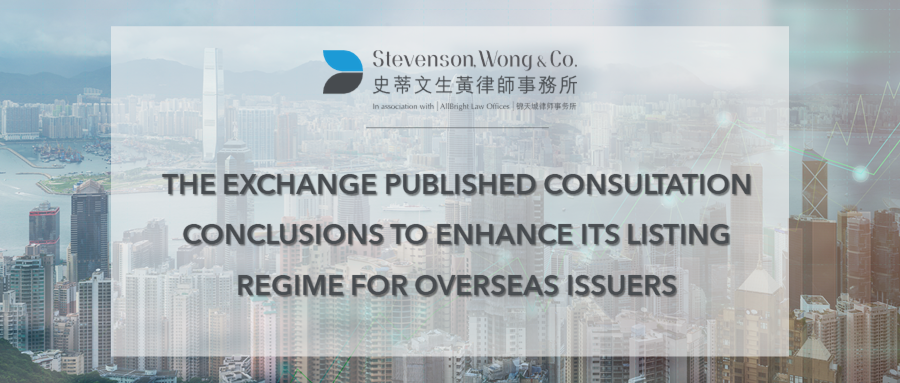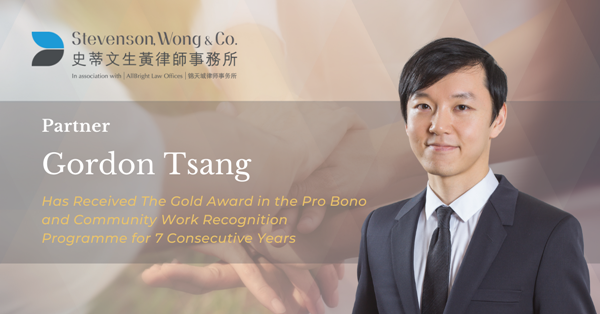Background
On 19 November 2021, The Stock Exchange of Hong Kong Limited (the “Exchange”) published its consultation conclusions (the “Consultation Conclusions”) as to its proposal to enhance and streamline the listing regime for overseas issuers. The amended Rules Governing the Listing of Securities on the Exchange (the “Listing Rules”) and the new guidance materials become effective from 1 January 2022.
The said proposals received large support from the public. As such, the Exchange has concluded to adopt all the proposals outlined in its consultation paper on enhancing and streamlining the listing regime for overseas issuers on 31 March 2021 (the “Consultation Paper”) with minor modifications. This article follows up with our news update in April 2021 on the Exchange’s Consultation Paper. The capitalised terms used herein shall have the same meaning as defined in the Consultation Conclusions and Consultation Paper.
In summary, the revised listing regime will be based on the following:
- Streamlining shareholder protection standards into one set of “Core Standards”;
- Relaxing requirements on secondary listing regime for non-WVR Greater China Issuers, (a) without demonstration as an “innovative company”; and (b) lowering the minimum market capitalisation at listing than currently required;
- Allowing Grandfathered Greater China Issuers and Non-Greater China Issuers eligible for secondary listing with their existing WVR and/or variable interest entity structures to opt for a dual primary listing; and
- Publishing new guidance materials for secondary listed issuers.

Key Summary of the Revised Listing Regime
The key points of the revised listing regime of Overseas Issuers are set out as follows.
Core Shareholder Protection Standards
- One common set of Core Standards will apply to all issuers (i.e. Hong Kong issuers, PRC issuers and Overseas Issuers), thereby providing the same level of protection to all investors. The Equivalence Requirement[1] will be repealed. Consequently, the concepts of “Recognised Jurisdictions” and “Acceptable Jurisdictions” shall also be removed.
- The Core Standards, largely derived from the JPS[2], comprise mainly the following:
- the notice and conduct of general meetings;
- members’ right to remove directors, requisition a meeting, vote, speak and appoint proxies or corporate representatives;
- the reservation of auditor appointment, etc. to a committee independent of the board of directors of a company or a majority of the shareholders and the reservation of certain other material matters to supermajority votes by shareholders;
- restrictions on the term of a director appointed to fill a casual vacancy;
- availability of the shareholders’ register for inspection; and
- restrictions on shareholder voting on certain matters required by the Listing Rules.
- With regard to PRC Issuers, the Exchange accepts certain modifications to certain Core Standards (i.e. allowing different minimum length of notice period for general meetings and the use of the two-thirds majority definition of a “super-majority vote” for approving a variation of class rights, amendments of constitutional documents and voluntary winding-up) so that while complying with the Mandatory Provisions, they can also attain a reasonably comparable level of shareholder protection standards to Hong Kong issuers and Overseas Issuers.
- Existing listed issuers will have to determine if their constitutional documents are in full compliance with the Core Standards. Otherwise, they would have until their second annual general meeting following 1 January 2022 to make any necessary amendments to comply with the Core Standards.
Dual Primary Listing
- Grandfathered Greater China Issuers and Non-Greater China Issuers eligible for secondary listing while retaining their Non-compliant WVR and/or VIE Structures may opt for a dual primary listing if they meet the requirements of Chapter 19C of the Listing Rules for Qualifying Issuers seeking a secondary listing with a WVR structure (which are more rigorous than those applicable to other primary listing applicants without WVR structures).
- They shall not be entitled to the Automatic Waivers as they are applying for dual primary listing instead of secondary listing. Hence, they shall be subject to the full set of Listing Rule requirements, save for those requirements waived on a case-by-case basis. The Exchange will also reserve its right, in its absolute discretion, to refuse a listing of securities of an issuer if its WVR structure represents an extreme case of non-conformance with corporate governance norms.
- Grandfathered Greater China Issuers and Non-Greater China Issuers are allowed to retain Non-compliant WVR and/ or VIE Structures if they are subsequently de-listed from their Qualifying Exchange. The Exchange retains its absolute discretion to impose further requirements on these issuers on a case-by-case basis, considering, among other things, their compliance history with the Listing Rules and any material non-compliance on the Qualifying Exchange.
Secondary Listing Requirements
- Relaxing requirements on secondary listing regime for Overseas Issuers (including those with a centre of gravity in Greater China) without WVR structures by removing the condition of being an “innovative company” (i.e. having the relevant characteristics set out in paragraphs 3.2 to 3.4 of GL94-18). These issuers shall now be required to satisfy either one of the two of the following requirements:
Criteria A
- a track record of good regulatory compliance of at least five full financial years on a Qualifying Exchange (for any Overseas Issuer without a WVR structure) or on any Recognised Stock Exchange (only for Overseas Issuers without a WVR structure and without a centre of gravity in Greater China); and
- an expected market capitalisation at the time of secondary listing of at least HK$3 billion.
Criteria B
- a track record of good regulatory compliance of at least two full financial years on a Qualifying Exchange; and
- an expected market capitalisation at the time of secondary listing of at least HK$10 billion.
- The Exchange retains the discretion to reject a secondary listing application if it believes that it is used as a way to circumvent the Listing Rules that apply to primary listing. The Exchange shall also retain the discretion to apply their reverse takeover requirements, in order to prevent regulatory arbitrage. In particular, in cases where an applicant for secondary listing was primary listed on an overseas exchange through a de-SPAC transaction which was not subject to the IPO due diligence or eligibility requirements applicable to new listings, it might indicate that the secondary listing application constitutes an attempt at regulatory arbitrage, and the Exchange will therefore apply the reverse takeover test to such companies.
Secondary listed issuers’ conversion to primary listing status
- The Trading Migration Requirement[3] shall be applicable to all issuers with a secondary listing to make sure consistency of the principles on which Automatic Waivers are given.
- A secondary listed issuer will be regarded as a primary listed issuer in the case of: delisting from the exchange of primary listing (“Route 1”) and as dual primary listed issuer in the case of migration of the majority of the Overseas Issuer’s listed shares migrates to the Exchange’s markets on a permanent basis (“Route 2”); or voluntary conversion (“Primary Conversion”) to dual-primary listing (“Route 3”).
- Route 1 – For issuers delisted from the overseas exchange:
- A 12-month automatic grace period available for the preparation of financial statements in accordance with HKFRS/ IFRS upon delisting from the primary listing market.
- Automatic Waivers will be disapplied in respect of other Listing Rules upon being delisted from the primary listing market.
- Regarding involuntary delisting from the overseas exchange, transitional arrangements shall apply for continuing transactions which are entered into before the issuer’s notification of the involuntary delisting to the Exchange so that the transactions are exempt from applicable Listing Rules for 3 years from the date of the delisting notification.
- In the event that an Overseas Issuer expects difficulty in complying with specific applicable Listing Rules, a grace period may be granted on a case-by-case basis. The Exchange reserves the power to require the issuer’s stock short name to include a special stock marker (TP) to indicate that the issuer is a primary listed issuer under transitional arrangements.
- Route 2 – For issuers that become primary listed in Hong Kong as a result of Migration:
- Upon the majority of trading in the Overseas Issuer’s listed shares (i.e. 55% or more of the total worldwide trading volume, by dollar value, of those shares) migrates to the Exchange’s markets on a permanent basis over the overseas issuer’s most recent financial year, all Automatic Waivers will be revoked subject to the existing transitional arrangements of Chapter 19C.
- Route 3 – For issuers that become dual primary listed in Hong Kong as a result of Primary Conversion:
- All Automatic Waivers shall be revoked upon the effective date of Primary Conversion and a grace period for full compliance with the Listing Rules will not normally be allowed.
Analysis and Takeaways
The revised listing regime enhances and streamlines the Exchange’s approach to Overseas Issuer listings as a whole. It clarifies the applicable requirements, thereby creating incentives for overseas issuers primary listed elsewhere to explore possibilities of applying for dual primary listing or secondary listing on the Exchange. Some of the more restrictive requirements for issuers with a centre of gravity in Greater China have been removed, and it is expected to attract more US-listed Greater China Issuers to seek “homecoming” secondary listing attempts on the Exchange.
Please contact our Partner Mr. Rodney Teoh for any enquiries or further information.
This newsletter is for information purposes only. Its content does not constitute legal advice and should not be treated as such. Stevenson, Wong & Co. will not be liable to you in respect of any special, indirect or consequential loss or damage arising from or in connection with any decision made, action or inaction taken in reliance on the information set out herein.
[1] the requirement that shareholders of non-Hong Kong issuers shall be afforded shareholder protection at least “equivalent to” that provided in Hong Kong.
[2] Joint policy statement regarding the listing of overseas companies” first published jointly by the Exchange and the Securities and Futures Commission in 2007, updated on 27 September 2013, and last amended on 30 April 2018
[3] the requirement under Rule 19C.13 of the Listing Rules that if the majority of trading in a Greater China Issuer’s listed shares migrates to the Exchange’s markets on a permanent basis, the Exchange will regard the issuer as having a dual primary listing and consequently the Automatic Waivers will no longer apply to such issuer

